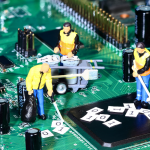
Introduction
When developing a new product, selecting the right microcontroller unit (MCU) is a critical decision. The MCU serves as the brain of the device, influencing its performance, functionality, and power consumption. With a wide range of MCUs available, each offering unique features and capabilities, choosing the right one can be challenging. In this article, we will explore the factors to consider when selecting an MCU, supported by existing technologies and real-world examples.
I. Understanding the Application Requirements
1.1 Defining Product Specifications
Before choosing an MCU, it is essential to clearly define the product’s specifications and requirements. Factors such as processing power, memory size, input/output interfaces, connectivity options, and power consumption must be carefully considered.
1.2 Real-Time Processing Needs
If the application requires real-time processing, selecting an MCU with a fast and efficient processor is crucial. Real-time applications, such as robotics or control systems, demand MCUs with high clock speeds, low interrupt latency, and efficient interrupt handling mechanisms.
1.3 Real-World Example: Robotics
In the field of robotics, choosing the right MCU is paramount. The Arduino platform, for instance, offers a range of MCUs suitable for different robotic applications. The Arduino Due, powered by an ARM Cortex-M3 processor, provides the necessary processing power and real-time capabilities required for advanced robot control.
II. Evaluating Development Tools and Ecosystem
2.1 Availability of Development Tools
The availability of robust and user-friendly development tools greatly influences the development process. The presence of an integrated development environment (IDE), comprehensive libraries, debugging tools, and community support can significantly streamline the software development process and accelerate time-to-market.
2.2 Supportive Ecosystem
A vibrant and supportive ecosystem is essential for developers working with MCUs. Communities, forums, and online resources can provide valuable insights, troubleshooting assistance, and access to code examples. A strong ecosystem ensures that developers have the necessary support to overcome challenges and explore the full potential of the chosen MCU.
2.3 Real-World Example: STM32 Ecosystem
STMicroelectronics’ STM32 microcontroller family is well-known for its comprehensive development ecosystem. The STM32Cube software development platform, combined with the STM32 Nucleo development boards and the STM32 community, offers developers a robust environment for rapid prototyping and development. The availability of documentation, tutorials, and online forums makes it easier for developers to leverage the full potential of the STM32 MCUs.
III. Considering Power Consumption and Efficiency
3.1 Power Requirements
Power consumption is a critical consideration, particularly for battery-powered or energy-efficient devices. The MCU’s power consumption during active operation, idle modes, and sleep modes can greatly impact the device’s battery life and overall efficiency.
3.2 Low-Power Modes and Features
MCUs often incorporate low-power modes, such as sleep or standby modes, to minimize power consumption during idle periods. Additionally, features like dynamic voltage scaling and clock gating can further optimize power usage based on the application’s needs.
3.3 Real-World Example: Low-Power IoT Devices
In the field of Internet of Things (IoT), where devices are often battery-powered and require long-lasting operation, selecting an MCU with low power consumption is crucial. The Nordic Semiconductor nRF52 series, for example, offers MCUs specifically designed for low-power IoT applications. These MCUs feature ultra-low power consumption, enabling devices to operate for extended periods without frequent battery replacement.
Conclusion
Choosing the right MCU for your next product is a critical decision that can greatly impact its performance, functionality, and power consumption. By understanding the application requirements, evaluating the development tools and ecosystem, and considering power consumption and efficiency, developers can make an informed decision. Real-world examples, such as the Arduino Due for robotics, the STM32 ecosystem, and the Nordic Semiconductor nRF52 series for low-power IoT devices, demonstrate the importance of selecting the right MCU for specific applications. As technology continues to advance, the availability of diverse MCUs with improved features and capabilities opens up new possibilities for innovative and efficient product development.

















